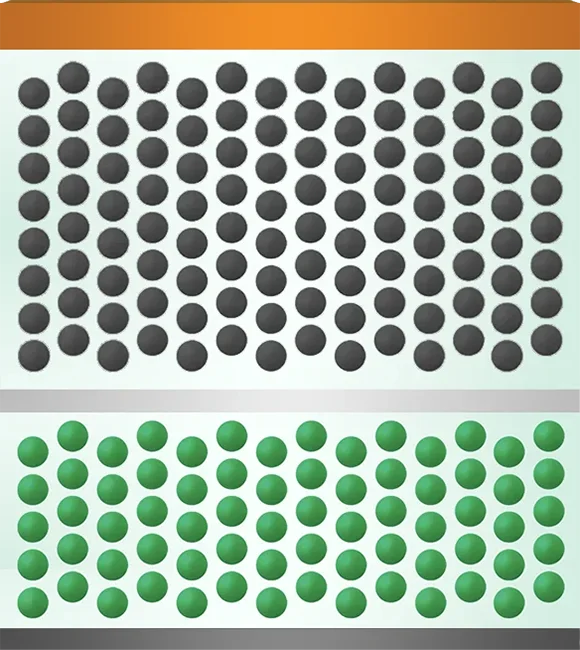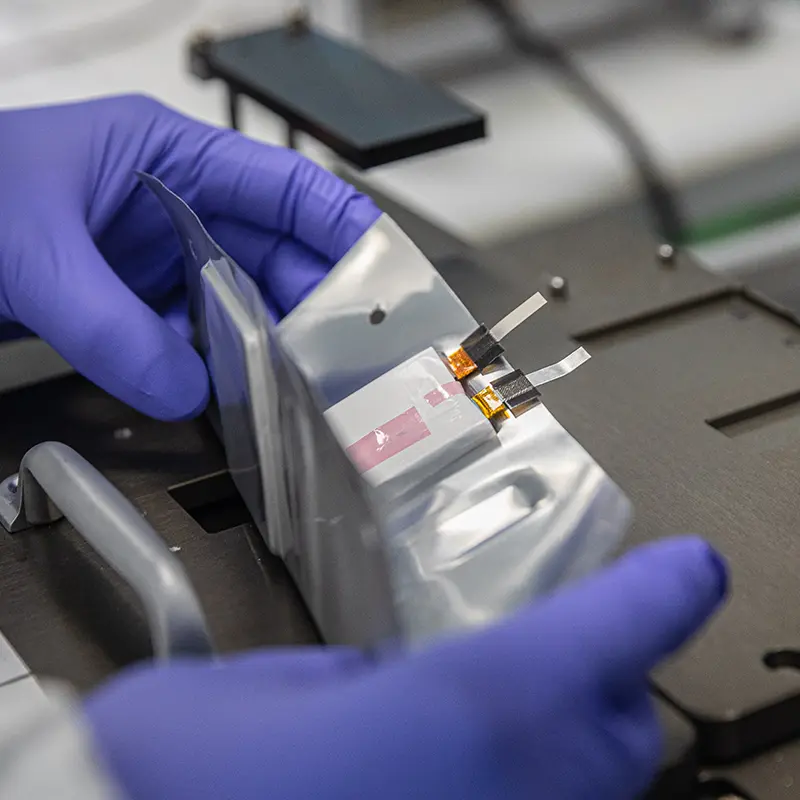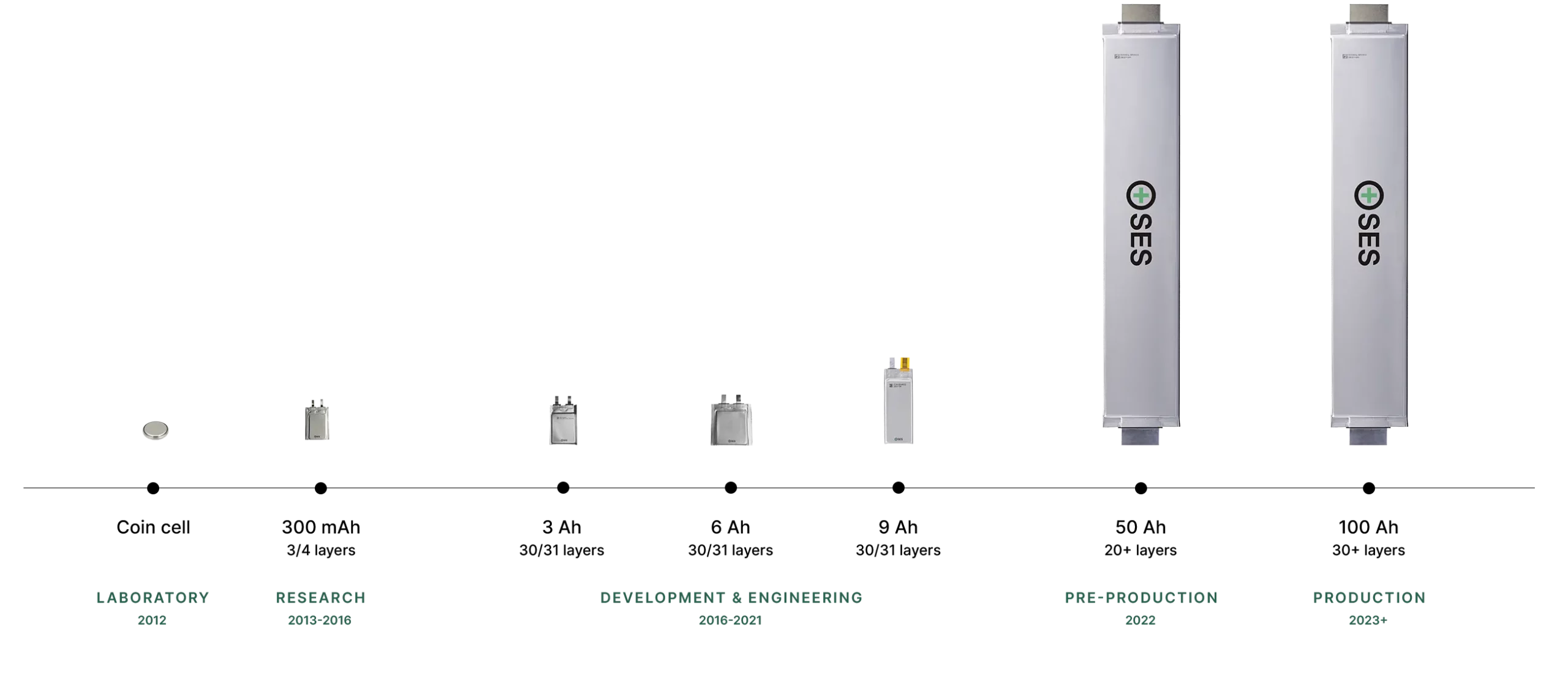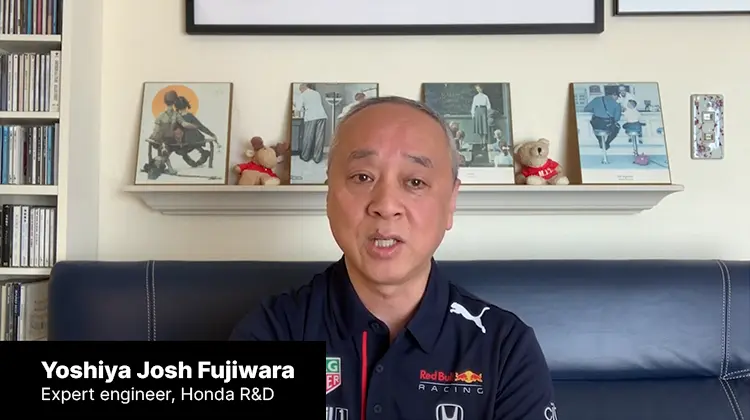SES AI’s Li-Metal batteries will enable a new era of aerial electric transportation
In 1991, Sony commercialized the first Li-ion battery and kicked off an era of portable electronics. More than 30 years later, SES AI is developing and commercializing the first Li-Metal battery and will kick off an era of electric transportation in air.

Hermes

Apollo
Apollo is large format EV and eVTOL cells that combine the latest material development from Hermes and the best Li-Metal cell engineering and manufacturing. These can be customized for different OEM requests. Currently, we are developing and manufacturing (pilot-scale) 50Ah to >100Ah Li-Metal cells for EV and eVTOL applications with GM, Hyundai, and Honda in our Shanghai China and Chungju Korea lines. In 2021, we introduced the world’s first 100Ah Li-Metal cell.
Avatar
Avatar is an AI-powered “digital twin” equivalent of physical Li-Metal batteries. Battery health is like human health, which depends on genetic inheritance, nutrition during pregnancy, and lifestyle. These three sets of data are mapped to battery Avatar as material information, manufacturing quality data, and real-world vehicle data. Avatar is a new fundamental breakthrough in integrating Hermes material information, Apollo cell design and manufacturing information, quality management, and actual vehicle mission profile, to precisely monitor battery health and predict failures and incidents.
SES AI’s approach versus other approaches
SES AI is pioneering a hybrid battery approach

Conventional Li-ion

- Energy density
- Manufacturability
Solid-state Li-Metal

- Energy density
- Manufacturability
SES AI hybrid Li-Metal

- Energy density
- Manufacturability










SES AI’s innovative hybrid Li-Metal approach
SES AI’s original approach was a solid-state Li-Metal battery. However, through our research and development efforts, we realized the limitations of all-solid-state batteries: they require high temperature to be operational and are very difficult to scale up. We then pivoted to a solution that would meet EV and eVTOL requirements while allowing us to manufacture batteries at scale using existing infrastructure and processes.
Today, SES uses a hybrid Li-Metal approach that involves several key technologies, including:
- An innovative and proprietary high-concentration solvent-in-salt electrolyte, which fundamentally changes the way lithium dendrites grow
- A protective coating that further stabilizes the interface between the electrolyte and Li-Metal anode
- A composite Li-Metal anode that has a fundamentally different lithium dendrite formation mechanism
SES AI is also layering in an AI-powered battery health monitoring algorithm, large format Li-Metal cell engineering and manufacturing capability, and other technological advancements to create a first-of-its-kind battery that will power a new era in electric transportation.
Key breakthrough: our proprietary and patented liquid electrolyte
Electrolyte composition
- Salt: A single or multiple salt(s) with purity profile and trade secret purification process
- Solvent: Proprietary and patented solvent that SES designed and synthesized not commercially available
- Additives: Proprietary/trade secret


A safe place to innovate and test
Pioneering a first-of-its-kind Li-Metal battery requires the ability to safely try new things. SES AI’s state-of-the-art facilities are equipped with several bunkers, a place where we can safely innovate, test, fail, learn, and repeat. Here we test hundreds and thousands of 100Ah Li-Metal cells.
SES AI believes in full transparency and regularly publishes our cell test data and results on our website. We will continue to publish data reports regularly to keep the industry updated as we improve everything from materials to engineering to manufacturing quality.
Watch how our Li-Metal batteries are made


Introducing the world's first large-format 100Ah Li-Metal cells
- Denser. >400 Wh/kg and 1,000 Wh/L, providing longer range for EVs and eVTOLs
- Lighter. Ultra-thin Li-Metal anode reduces battery weight
- Scalable. Manufacturable at scale using existing Li-ion processes
- Smarter. AI-powered algorithm monitors battery health
Li-Metal battery




Li-Metal anode
electrolyte formula
and allows for high manufacturability

Introducing the world's first large-format 100Ah Li-Metal cells
- Denser. >400 Wh/kg and 1,000 Wh/L, providing longer range for EVs and eVTOLs
- Lighter. Ultra-thin Li-Metal anode reduces battery weight
- Scalable. Manufacturable at scale using existing Li-ion processes
- Smarter. AI-powered algorithm monitors battery health
SES AI’s Li-Metal Battery

SES AI is the first company in the world to enter into A sample JDAs with three major automotive OEMs




“Let's communicate closely in the common language of technology and be the first in the world to bring the Li-Metal battery to the automobile market."
YOSHIYA JOSH FUJIWARA
Expert engineer, Honda R&D
